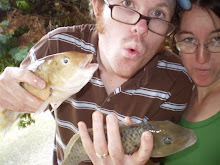A Northern Red-legged Frog (Rana aurora aurora)
This week Anna and I will begin leading a survey of potential frog-breeding sites. Anica -‘conda’ Burianyk began this project last year, surveying 9 ponds in the Little Campbell Watershed for the presence of Northern Red-legged Frog egg masses. Northern Red-legged Frogs (NRLFs) are a threatened frog species in British Columbia. The main threats to NRLFs are degradation or loss of habitat, and predation and competition from introduced Bullfrogs.
NRLFs are very beautiful reddish brown frogs, with small black ‘freckles,’ prominent dorsolateral folds and stunning red colouring on their hind legs, hence their name. You can often see the leg bones right through their skin!
If you look close enough you can see the hind leg bones
NRLFs tend to live in moist forests and wetlands with trees. I have come across about a half a dozen of these critters, whilst removing lamium from a boggy area near the ponds. They prefer to breed in shallow ponds or slow streams that are have vegetation cover for shade. Females lay between 200 and 1300 eggs per season in large jelly-like clusters (typically grapefruit sized) attached submerged sticks or stems of aquatic plants. After breeding, adults leave the ponds for the summer abodes, typically in riparian zones, which may be up to half a kilometer away. While starting out as vegetarian tadpoles, adult NRLFs happily hunt insects and other small invertebrates.
Two NRLF egg masses attached to submerged sticks
Few studies of this frog have been undertaken in BC, leaving many questions about its current range and population status.
Anica sought to address these questions by surveying ponds in the Little Campbell Watershed that had suitable surrounding vegetation that could, at least in theory, support populations NRLFs. She visited 9 ponds over 4 weeks looking for NRLF egg masses. It takes considerable skill to indentify the sources of different blobs of jelly. To determine the species you need to look at egg mass size, egg mass shape, the size of individual eggs, the colour of the eggs, density of the eggs, attachment of the eggs… After a few hours of studying eggs masses you slowly gain in confidence but there are always some masses that seem to break the rules. Of the 9 ponds, 6 had NRLF egg masses, with up to 40 egg masses found one week in one of the ponds at the centre.
A close-up of an NRLF egg mass. Each black dot is one egg
Anica rated the habitat value of each site by estimating the presence of suitable forest and vegetation in a 200 metre radius of the pond. All the ponds with a high habitat value had NRLF egg masses. She also found that NRLFs seem to prefer laying their eggs onto submerged sticks.
So what are we doing? We are going to repeat her survey, visiting all the ponds she visited and adding about another 5 new ponds to list. We will follow her optimized methodology, recording pond temperature each week and rating the habitat value of new sites to build up the data about this beautiful frog species.
A Northwestern Salamander egg mass attached to blackberry branch. This species has egg masses slightly smaller than NRLF (about the size of a lemon) that are a more solid mass and that are less densely packed.
A Pacific Tree Frog egg mass attached to a stick. These eggs are smaller than NRLF eggs and the mass is more of a sausage shape. Mmmmm sausages.
Hmmmm. What could this egg mass be? First correct answer just might get a prize!
Over the past 6 weeks we have been introduced to a large number of amphibians. We would like you to meet some of our friends.
Pacific Tree Frog - these come in a whole range of colours from dark green, to browny, to bright green!
Rough Skinned Newt - its orange underbelly warns you that it is poisonous
Northwestern Salamander - we come across their eggs a whole lot
Western Toad - has more warts than you average witch
This post is dedicated to Curly the Highland cow who died this past weekend.















No comments:
Post a Comment